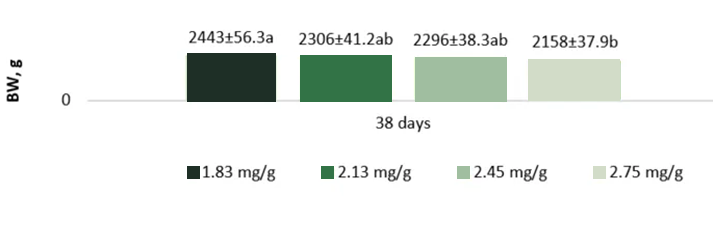



Soy trypsin inhibitors do affect the growth and gut health of chickens
Introduction
As global animal production has rapidly shifted towards antibiotic free, “Gut health” has become a popular expression and all-encompassing concept in the scientific community. Pluske et al. (2018) defined gut health as a generalized condition of homeostasis in the gastro-intestinal tract, with respect to its overall structure and function. The gastro-intestinal tract must provide a barrier function protecting against harmful environmental elements (e.g. toxins and pathogenic microbes), while simultaneously permitting appropriate nutrient absorption. Successful animal performance depends on the interplay between the intestine, microbiota, diet, and a multitude of environmental factors. Inherent, persistent challenges with successful transitioning from conventional poultry production that utilizes growth promoters to antibiotic free production has facilitated an interest in elucidating what negative factors may have been previously masked through antibiotic usage, for example, the impact of various ingredient’s nutrient compositions.
The shift to antibiotic free production often results in the increase of soybean meal inclusion as all-vegetarian fed programs are limited in the number of efficacious protein sources that successfully reduce soybean meal content. Soybean meal is the most widely used major protein source in poultry production across the world. Soybean meal has a consistent, ideal amino acid profile for poultry and is particularly abundant in lysine (United Soybean Board, 2019). However, SBM contains various anti-nutritional factors that may affect intestinal homeostasis and impair nutrient utilization in poultry. The main anti-nutritional factors in SBM, are trypsin inhibitors (TI), oligosaccharides, such as raffinose and stachyose, and the antigen β-conglycinin. Diets that include high levels of soybean meal contain proportionally higher anti-nutritional factors and may pose the risk of impaired performance.
Garcia-Rebollar et al. (2016) analyzed the content of TI and oligosaccharides in more than 400 samples of SBM from different origins (USA, Brazil and Argentina). Researchers observed a high degree of variability in the reported ANF values, both within the same country and amongst different origins (Table 1). The elevated variability and its potential negative impact on performance highlights the importance of knowing the content of anti-nutritional factors in SBM for poultry formulations.
In this article, we will review the role of trypsin inhibitors in broilers.
Trypsin inhibitors; beyond digestion problems
Excessive quantities of TI in feed will cause pancreatic hypertrophy leading to poor growth and decreased performance (Pacheco et al. 2014; García-Rebollar et al. 2016; Rada et al. 2017). This pancreatic hypertrophy is a compensatory modulation by the body to offset the effect of ingested trypsin inhibitors (Liener 1981; Waldroup et al. 1985). However, this mechanism is limited and is not effective in overcoming the continuous daily intake of high amounts of TI, ultimately reducing the digestibility of the dietary protein. Rada et al. (2017) observed the negative effect of increasing TI activity on body weight gain and FCR in broiler diets at 38 days of age (Figures 1 and 2).


a-b Values with different subscript are significantly different (p<0.05)
Figure adapted from Rada et al. 2017

a-b Values with different subscript are significantly different (p<0.05)
Figure adapted from Rada et al. 2017
Rada et al. 2017 observed by reducing the level of TI activity in the diet by approximately 15%, it was possible to increase the weight of broilers by more than 100 g at 38 days of age and decrease the FCR by 4 points. Although the heating process in manufacturing SBM significantly reduces the TI content, there is substantial variability in the TI content in SBM, as reported by García-Rebollar et al. (2016). In starter feeds formulated with more than 30% of SBM, TI concentrations can exceed 2 mg/g, compromising the growth of chickens.
Strategically, reducing SBM content below 30% in starter feed diminishes adverse performance attributed to high TI in finished feed.
High TI content in feed impairs the digestion of the protein which directly affects the intestinal health of chickens. Palliyeguru et al. (2011) demonstrated dietary soy TI elicited an increased severity of sub-clinical necrotic enteritis (Figure 3). When amino acid digestibility is compromised, the ileal ingesta will have a relatively high content of undigested amino acids that pass into the large intestine and cecal tonsils, where microbial fermentation will occur. C. perfringens, a pathogenic agent of necrotic enteritis, needs specific amino acids and peptides for its proliferation (Nakamura et al., 1968). Diets containing high TI and low amino acid digestibility are predisposed to rapid multiplication of C. perfringens. This may be correlated to trypsin inhibitors exacerbation of C. perfringens toxins, as the toxins are not hydrolyzed by proteases in the intestine, perpetuating the severity of their toxigenic effects, as suggested by Palliyeguru et al., 2011.

SED = 0.096
Significant linear effect
Figure adapted from Palliyeguru et al. 2011
In conclusion, there is scientific evidence on the negative effect of soybean trypsin inhibitors in chickens. They can not only adversely affect the productive performance of chickens but can also impair their intestinal health.










